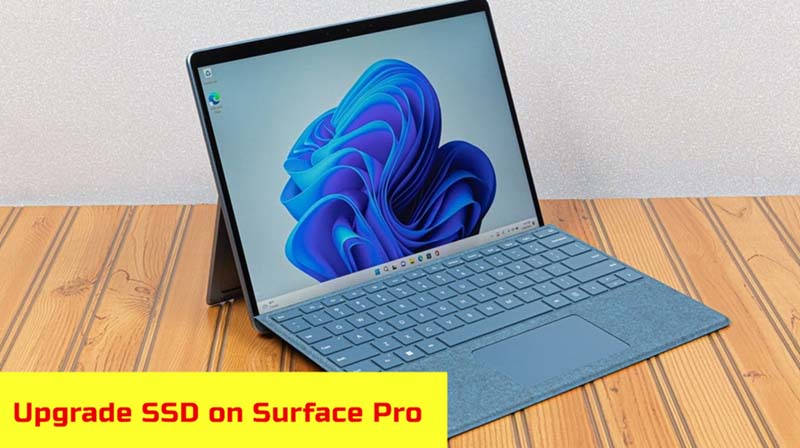PAGE CONTENT:
Upgrading the SSD in a Microsoft Surface Pro can greatly improve its speed and storage space, making it a more powerful and useful device. This guide will walk you through the whole process, from getting ready to put everything back together, so you can be sure you can finish the upgrade smoothly.
These steps will show you how to safely remove your Surface Pro SSD, install a new SSD, and restore the operating system. This update can give your device a new lease on life by making it faster to start, giving you more storage space, and making it easier to use.
This guide will give you proper steps and useful tips to make the upgrade go as smoothly as possible, even though you must be careful and know a bit about computers.

Upgrade SSD on Microsoft Surface Pro
1. Backup Your Data
Before you start the hardware upgrade, back up all of your important info. Use an external hard drive or a cloud storage service to ensure you don't lose any files during the process.
- Connect your 16GB or more USB drive to the Surface Pro.
- You can find Recovery Drive and open the app.
- You don't need to back up system files to the restore drive, so uncheck the box next to it.
- Format and wipe the drive as instructed. This step sets up the USB as a Windows 11 restore drive that can start up.
- Your Surface Pro serial number will let you download the 6.4GB of Recovery Files for your Surface Pro.
- The Surface Pro Recovery Files should be unzipped and on the USB drive. Any copies should be copied over.
For now, put the thumb drive somewhere else. You'll need it after you swap the SSD.
2. Create Windows Installation Media
After upgrading your SSD, you must make a bootable USB drive to restart Windows. Do these things:
- Visit the Microsoft Windows download page.
- Get the Windows Media Creation Tool here.
- Run the tool and follow the on-screen directions to make a bootable USB drive.
3. Power Off the Device
Before disassembling your Surface Pro, ensure it is turned off and remove any external chargers and gadgets.
4. Disassembling the Surface Pro
The hardest part of the process is taking the Surface Pro apart. Carefully follow these steps to prevent your gadget from breaking.
Remove the Screen
- Heat the Edges: Warm up the Surface Pro screen's edges with a hair dryer or a heat gun. It will weaken the glue holding the screen in place.
- Insert the Pry Tool: Carefully insert the plastic spudger or pry tool between the screen and the frame. To loosen the glue, work your way around the edges. Be gentle, and don't use too much force to prevent the screen from cracking.
- Lift the Screen: Slowly lift the screen once the glue is no longer stuck. Watch out for the wires that connect the screen to the computer's main board.
- Disconnect the Cables: Carefully pull the wires that connect the screen to the motherboard away with tweezers. Write down where they are so you can put them back together later.
Access the Internal Components
- Remove the Screws: Using the precision screwdriver, take out the screws that are holding the internal parts in place. You will need these screws to put the thing back together, so keep them safe.
- Lift the Shielding: Remove any covering or protective covers to get to the SSD.
5. Removing the Existing SSD
- Locate the SSD: The SSD is usually near the middle of the motherboard and is held in place by a single screw.
- Remove the Screw: The precision screwdriver can be used to take out the screw that is keeping the SSD in place.
- Remove the SSD: Pull it out of its slot slowly and at an angle.
6. Installing the New SSD
Insert the New SSD: With the hole a little tilted, insert the new SSD into it. Make sure it's sitting right.
Secure the SSD: To keep the new SSD in place, replace the screw.
7. Reassembling the Surface Pro
- Reconnect the Cables: Carefully connect any wires that you had previously disconnected. Please ensure they are tightly in place to avoid any problems with connectivity.
- Replace the Shielding: Put back on any shielding or protection covers that you took off.
- Reattach the Screen: Carefully put the screen back on the device, ensuring all the cables are linked. To seal the glue again, gently press down around the edges.
- Secure the Screen: You can warm the glue with a heater or heat gun to ensure the seal is strong if you need to.
8. Installing the Operating System
- Insert the USB Drive: Put the working USB drive you made earlier in the Surface Pro.
- Power On the Device: To reach the BIOS or UEFI settings, turn on the Surface Pro and press the right key (usually F2, F12, or Del).
- Boot from USB: Change the boot order to run the USB drive. Save your changes, then turn the device back on.
- Install Windows: To run Windows on your new SSD, follow the steps shown on the screen. During this step, you might need to reset the SSD.
9. Post-Upgrade Tips
Install Drivers and Updates
After installing Windows, ensure that all the necessary drivers are loaded. Users can download and install the latest Surface Pro drivers from the Microsoft website.
Restore Your Data
After setting up the operating system and drivers, use the backup you made earlier to restore your files.
Optimize SSD Performance
The following tips will help you get the most out of your new SSD:
- Enable TRIM: With the TRIM command, you can help an SSD keep working well over time. If you open the Command Prompt and type fsutil behavior query DisableDeleteNotify, you can see if it is turned on by default in Windows. If it gives back 0, TRIM is on.
- Disable Disk Defragmentation: SSDs don't need traditional disk defragmentation, which can even shorten their life. Make sure that it is turned off in the Disk Defragmenter options.
- Update Firmware: Check the SSD maker's website for any firmware changes for your new SSD. Updating the software can improve performance and stability.
How to Clone Data from Old SSD to New SSD on Surface Pro?
If you want to clone all data from old SSD to new SSD without reinstalling Windows OS, you can use disk cloning program to move all data from your Surface Pro to the new SSD, then set the new SSD as the boot drive.
Step 1. Download and install the reliable Microsoft Surface disk cloning program - Donemax Disk Clone on your Surface Pro.
Step 2. Make sure the SSD is connected to the Surface Pro. Open Donemax Disk Clone, choose Disk Clone mode. Select the old SSD as the source disk, select the new SSD as the destination disk. Click Next.

Step 3. Tick Check the option if the destination is SSD. Then click on Clone button to securely clone all data from the old SSD to the new SSD.

Step 4. Once the clone is completed, you can set the new SSD as the boot drive.
Conclusion:
Upgrading the SSD in your Microsoft Surface Pro makes it run faster and store more data. The process requires careful taking apart and precise putting back together, but this guide lays out all the steps you need to make the change work. Always make a copy of your data, be careful with parts, and carefully follow each step.
Once the upgrade is complete, you can enjoy a faster, more efficient device by reinstalling the operating system, updating the drivers, and restoring your files. If you are patient and pay close attention to the little things, you can give your Surface Pro a new lease on life and ensure it works for years.
Related Articles
- Jul 28, 2024How to Boot from An External Hard Drive?
- Apr 21, 2024How to Upgrade HDD/SSD to Large Disk Without Data Loss?
- May 27, 2024What Is Windows 10 Recovery Partition? How to Move This Partition?
- May 26, 2024How to Clone SSD to HDD without Data Loss?
- May 13, 2024How to Clone Operating System?
- Mar 18, 2025How to Clone Windows 11/10/8 to a Seagate External Hard Drive

Lucien
Lucien is a writer and a chief programmer of Donemax software who has worked in the company for 5+ years. He has written much of the content on the site and devotes to providing troubleshooting and solution for Windows and Mac users including disk cloning, data recovery, migration, eraser, error fixes.

Gerhard Chou
In order to effectively solve the problems for our customers, every article and troubleshooting solution published on our website has been strictly tested and practiced. Our editors love researching and using computers and testing software, and are willing to help computer users with their problems